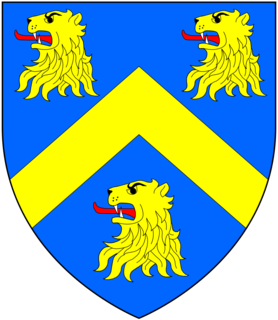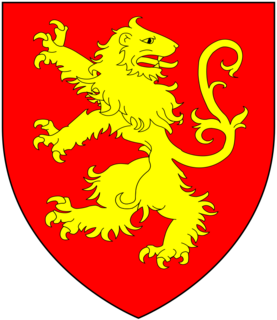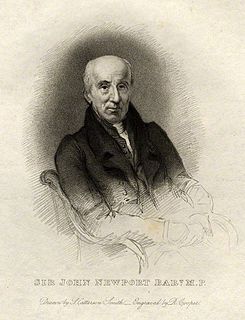
A baronet or the rare female equivalent, a baronetess, is the holder of a baronetcy, a hereditary title awarded by the British Crown. The practice of awarding baronetcies was originally introduced in England in the 14th century and was used by James I of England in 1611 as a means of raising funds.
Earl of Bradford is a title that has been created twice, once in the Peerage of England and once in the Peerage of the United Kingdom. It was first created in 1694 for Francis Newport, 2nd Baron Newport. However, all the Newport titles became extinct on the death of the fourth Earl in 1762. The Earldom was revived in 1815 for Orlando Bridgeman, 2nd Baron Bradford. The Bridgeman family had previously succeeded to the Newport estates. The title of the peerage refers to the ancient hundred of Bradford in Shropshire, and not, as might be assumed, to the city of Bradford, Yorkshire.

Viscount Scarsdale, of Scarsdale in the County of Derby, is a title in the Peerage of the United Kingdom. It was created in 1911 for the prominent Conservative politician and former Viceroy of India George Curzon, 1st Baron Curzon of Kedleston, who was created Earl Curzon of Kedleston at the same time and was later made Marquess Curzon of Kedleston.

Viscount St Davids, of Lydstep Haven in the County of Pembroke, is a title in the Peerage of the United Kingdom. It was created in 1918 for John Philipps, 1st Baron St Davids. The Philipps family descends from Sir John Philipps, who represented Pembrokeshire in the House of Commons. In 1621 he was created a Baronet, of Picton Castle in the County of Pembroke, in the Baronetage of England. His grandson, the third Baronet, also sat as Member of Parliament for Pembrokeshire. He was succeeded by his son, the fourth Baronet. He represented Pembroke and Haverfordwest in Parliament. His son, the fifth Baronet, sat for Haverfordwest. He was succeeded by his younger brother, the sixth Baronet. He represented Carmarthen, Petersfield and Pembrokeshire in the House of Commons.

Baron Roborough, of Maristow in the County of Devon, is a title in the Peerage of the United Kingdom. It was created in 1938 for Sir Henry Lopes, 4th Baronet. He had earlier represented Grantham, Lincolnshire, in Parliament as a Conservative. The Baronetcy, of Maristow in the County of Devon, had been created in the Baronetage of the United Kingdom in 1805 for Manasseh Masseh Lopes, a member of a wealthy family of Portuguese origin, with special remainder to his nephew Ralph Franco, son of his sister Maria. Manasseh Masseh Lopes converted to Christianity in 1802, and later represented Evesham, in Worcestershire, Barnstaple in Devon, and Westbury in Somerset, in Parliament. However, in 1819 he was twice convicted of bribing the voters in both Barnstaple and Grampound in order to be elected to Parliament, and was sentenced to imprisonment and heavy fines. He was also unseated by the House of Commons, but after his release from prison he nonetheless got elected for Westbury, a pocket borough which he controlled to a great extent.

Marquess of Ripon, in the County of York was a title in the Peerage of the United Kingdom. It was created in 1871 for the Liberal politician George Robinson, 2nd Earl of Ripon.

Earl of Egremont was a title in the Peerage of Great Britain. It was created in 1749, along with the subsidiary title Baron of Cockermouth, in the County of Cumberland, for Algernon Seymour, 7th Duke of Somerset, with remainder to his nephews Sir Charles Wyndham, 4th Baronet, of Orchard Wyndham, and Percy Wyndham-O'Brien. The Duke had previously inherited the Percy estates, including the lands of Egremont in Cumberland, from his mother Lady Elizabeth Percy, daughter and heiress of Joceline Percy, 11th Earl of Northumberland. In 1750 Sir Charles Wyndham succeeded according to the special remainder as second Earl of Egremont on the death of his uncle. His younger brother Percy Wyndham-O'Brien was created Earl of Thomond in 1756.

The Wigan Baronetcy, of Clare Lawn in Mortlake in the County of Surrey and Purland Chase in Ross in the County of Hereford, is a title in the Baronetage of the United Kingdom. It was created on 9 March 1898 for Frederick Wigan, a Director of the North London Railway. The presumed sixth Baronet has not successfully proven his succession and is consequently not on the Official Roll of the Baronetage. For more information, follow this link.
There have been four baronetcies created for members of the Astley family, three in the Baronetage of England and one in the Baronetage of the United Kingdom. Only one creation is extant as of 2008. The Astley family were descended from Sir Thomas de Astley of Astley, Warwickshire, who was killed in the Battle of Evesham in 1265. He married twice. From his first marriage to Joane de Blois descended the Astley baronets of Patshull, whose family seat was at Patshull Hall, Staffordshire, and the Astley baronets of Everley, Wiltshire. From his second marriage to Editha Constable of Melton Constable, Norfolk, descended the Astley baronets of Melton Constable, the Astley baronets of Hillmorton, and the Barons Astley of Reading.

The Morice Baronetcy, of Werrington in the County of Devon, was a title in the Baronetage of England.
The Miles Baronetcy, of Leigh Court in the County of Somerset, is a title in the Baronetage of the United Kingdom. It was created on 19 April 1859 for the banker and Conservative politician William Miles. His son, the second Baronet, was also a banker and Conservative politician. The family's bank, founded in 1750, eventually became part of NatWest.
The Mowbray Baronetcy, of Warennes Wood in the County of Berkshire, is a title in the Baronetage of the United Kingdom. It was created on 3 May 1880 for the Conservative politician John Mowbray. He served as Judge Advocate General from 1858 to 1859 and from 1866 to 1868 and was Father of the House of Commons from 1898 to 1899. Born John Cornish, he had assumed by Royal licence the surname of Mowbray in lieu of his patronymic in 1847. The second Baronet was also a Conservative politician.
There have been three baronetcies created for persons with the surname Laurie, one in the Baronetage of Nova Scotia and two in the Baronetage of the United Kingdom. One creation is extant as of 2007.
There have been four baronetcies created for persons with the surname James, one in the Baronetage of England, two in the Baronetage of Great Britain and one in the Baronetage of the United Kingdom. One creation is extant as of 2008.

The Molesworth, later Molesworth-St Aubyn Baronetcy, of Pencarrow near St Mabyn in Cornwall, is a title in the Baronetage of England. It was created on 19 July 1689 for Hender Molesworth, Governor of Jamaica.
The Colt Baronetcy, of St James's-in-the-Fields in the Liberty of Westminster in the County of Middlesex, is a title in the Baronetage of England. It was created on 2 March 1694 for Henry Colt, Adjutant to Prince Rupert of the Rhine and Member of Parliament for Newport and Westminster. The title was created with remainder to his younger brother John Dutton Colt, Member of Parliament for Leominster. Sir Henry died childless and was succeeded according to the special remainder by his great-nephew, the second Baronet. He was the grandson of John Colt.
The Oglander Baronetcy, of Nunwell in the County of Southampton, was a title in the Baronetage of England. It was created on 12 December 1665 for William Oglander, Member of Parliament for Yarmouth and Newport. The sixth Baronet was Member of Parliament for Bodmin. The title became extinct on the death of the seventh Baronet in 1874.

There have been two baronetcies created for persons with the surname Lennard, one in the Baronetage of England and one in the Baronetage of the United Kingdom. Both creations are extinct.

The Coryton Baronetcy, of Newton in the County of Cornwall, was a title in the Baronetage of England. It was created on 27 February 1662 for John Coryton, Member of Parliament for Callington, Cornwall and Launceston. He was the son of Sir William Coryton. The second Baronet represented Newport and Callington in Parliament. The third Baronet was Member of Parliament for Bossiney, Newport, Callington and Mitchell. The fourth Baronet represented Callington in Parliament. The title became extinct on his death in 1739.











